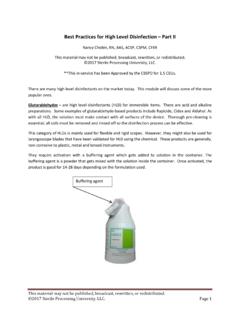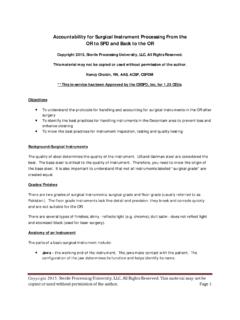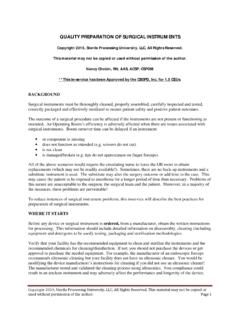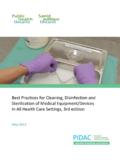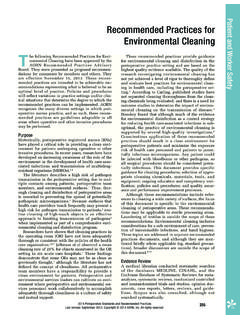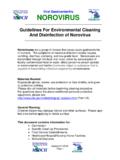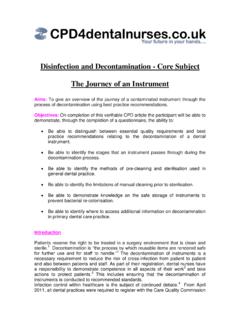Transcription of Best Practices for High Level Disinfection – Part I
1 This material may not be published, broadcast, rewritten, or redistributed. 2017 Sterile Processing University, LLC. Page 1 best Practices for high Level Disinfection part I Nancy Chobin, RN, AAS, ACSP, CSPM, CFER This material may not be published, broadcast, rewritten, or redistributed. 2017 Sterile Processing University, LLC. **This in-service has been Approved by the CBSPD for CEUs. The Bible for Chemicals is ANSI/AAMI - ST58:2013, Chemical sterilization and high - Level Disinfection in health care facilities . This document is a national standard that provides Guidelines for the selection and use of liquid chemical sterilants (LCSs)/ high - Level disinfectants (HLDs) and gaseous chemical sterilizers that have been cleared for marketing by the Food and Drug Administration for use in hospitals and other health care facilities. This in-service will only address high Level Disinfection . The LCS/HLD products that have been cleared for market by the FDA are listed on the FDA website ( ).
2 The list is updated when new high Level disinfectants are cleared for market. The information on the site includes: the concentration of active ingredients the sterilization or high - Level Disinfection contact time and temperatures, and the maximum reuse time period for each product. This website also identifies the LCSs/HLDs cleared by the FDA in a 510(k) with claims for processing reusable medical and dental devices. The HLD Environment It is strongly recommended that there is a designated area for high - Level Disinfection . high - Level Disinfection should occur in a clean environment to prevent recontamination of the medical device as it is removed from the process. The space used for cleaning/decontamination should be separate from the space used for high - Level Disinfection of medical devices, and these spaces should be separate from patient procedure areas and personnel support areas.
3 Material should flow in a one-way direction from the cleaning area to the high - Level Disinfection area and then on to storage or distribution. Where possible, solid walls should separate the cleaning area from the high - Level Disinfection area. In GI/Endo a separate room for HLD is strongly recommended. In SPD, HLD should be performed in a clean area ( the Prep/Packaging area), not in the Decontamination area. The floors, walls, and ceiling surfaces should be constructed of nonporous material and need to withstand frequent cleaning and wet conditions. Policies and procedures should be standardized throughout the health care facility or area, with emphasis on necessary engineering controls, appropriate personal protective equipment (PPE), hygiene, and safe work Practices . This material may not be published, broadcast, rewritten, or redistributed. 2017 Sterile Processing University, LLC.
4 Page 2 Sufficient space is needed for the preparation, quality monitors, chemicals, record-keeping supplies, and hand hygiene facilities. The high - Level Disinfection process should be located in a restricted-access area and should not be performed in high -traffic areas, near any potential sources of contamination, such as scrub sinks, hoppers, wash sinks, or containers for the disposal of linen and trash. Sinks of adequate size are needed for the disposal of the liquid chemical disinfectants. Proper ventilation is needed to ensure an irritation-free, safe, and comfortable work environment. If you detect chemical odors it could mean that the ventilation might not be adequate. Sometimes the odors of chemical high - Level disinfectants are masked ( perfume scent is included in the formulation). That does not mean the chemical may be safe. The ventilation system should be designed to control potential airborne concentrations of HLD.
5 Make sure that the ventilation system is operational at all times. high - Level disinfectants should always be used in an area that is properly ventilated. The room/location where the HLD is being used should have a minimum air exchange rate of 10 air exchanges per hour (check local regulations could be higher). Local exhaust ventilation should be located at the Level of the point of discharge of the vapors and pull vapors away from the work area, not toward personnel in the room. Fans and open windows should not be permitted (will interfere with the proper function of the ventilation system). Ventilation - Glutaraldehyde vapors are a respiratory irritant. In addition, the liquid can cause skin irritation. Always use glutaraldehyde products in a limited traffic area. The odors can be detected at Vents should be located at the point of discharge of the vapors (or at floor Level ) since glutaraldehyde fumes are heavier than air.
6 If you cannot control the fumes with ventilation, you can use a need local exhaust hood. Local Exhaust Ventilation - These units capture chemical vapors during processing. The hoods should be connected to non-re-circulating exhaust system to the outside of the building. If this is not possible, there are self contained systems. This material may not be published, broadcast, rewritten, or redistributed. 2017 Sterile Processing University, LLC. Page 3 One type of fume hood used to contain glutaraldehyde fumes The system should be designed to maintain adequate air movement to capture vapor from the top of the container and thereby minimize personnel exposure. Follow the manufacturer s instructions for use (IFUs) for operation and maintenance of the unit. Storage and Disposal of HLDs - Before using the HLD, consult with the IFU, the Safety Data Sheet (SDS) and the high - Level disinfectant product label for the specific product regarding for storage instructions.
7 Generally, unused chemical solutions should be stored in tightly closed containers; in a cool, secure and properly marked, well-ventilated area. They should not be stored under sinks which is an uncontrolled environment for temperature and humidity. Topping Off - It is unacceptable to top off a basin or automated endoscope reprocessor (AER) with a HLD solution unless the HLD disinfectant manufacturer has provided IFUs on this process. Understand that some volume of loss occurs with each processing cycle. Topping off does not extend the use life days of the solution even if the Minimum Effective Concentration (MEC) testing is still met. Training and Competencies - Competency should be assessed for all employees performing these activities upon orientation, whenever products or processes are changed, and at least annually thereafter. Only those personnel trained in the use of the specific high Level disinfectants(s) in use are authorized to be in the areas where high Level Disinfection is performed.
8 A copy of the Safety Data Sheet for the high Level disinfectant(s) in use must be available and reviewed by staff members. PPE - When processing instruments with chemical solutions, personnel should wear appropriate PPE designed to protect their skin, eyes, mucous membranes, and clothing from splashes. There should be a written policy and procedure for the PPE, including its correct use. Gloves, impervious to the chemical should always be worn if there is any possibility of contact with a chemical solution. Protect the forearms by wearing elbow-length gloves or by protective sleeves made of a material impervious to the chemical. Impervious or fluid resistant gowns provide additional protection to skin and clothing. Check with the manufacturer s SDS and written IFU for specific glove usage and protective clothing recommendations. Protect the eyes against contact with chemical solutions.
9 Vapor levels must be kept below any applicable OSHA permissible exposure limit (PEL). Check the SDS and product literature for specific eye protection and first-aid guidance. This material may not be published, broadcast, rewritten, or redistributed. 2017 Sterile Processing University, LLC. Page 4 Emergency Eyewash Stations - Suitable eyewash units must be available for immediate emergency use in all places where chemicals are used. The American National Standards Institute (ANSI) has established minimum performance criteria for eyewash units (ANSI Z358). Employees who may be exposed to hazardous materials must be instructed in the location and proper use of emergency eyewashes. Emergency eyewash units are available as a plumbed (connected to plumbing) or free-standing units. Eyewash units provide a minimum of gallons per minute continuously for at least 15 minutes, that they be designed to flush both eyes simultaneously, and that they have a "hands-free, stay open" feature once activated.
10 Under the ANSI standard, drench hoses or eyewash bottles are not acceptable emergency eyewash units. If installed on a sink, it must be a clean sink, not the Decontamination sink. Above meets ANSI eyewash unit Does not meet ANSI Requirements - Plumbed unit Requirements Self-Contained Eyewash Emergency eyewash units should be located within 10 seconds of travel time or 55 feet of travel distance of all chemical use locations. For a strong acid or strong caustic, the eyewash unit should be immediately next to the hazard. A door is considered to be an obstruction. Where the hazard is not corrosive, one intervening door can be present so long as it opens in the same direction of travel as the person attempting to reach the emergency eyewash and shower equipment and the door is equipped with a closing mechanism that cannot be locked to impede access to the equipment.
